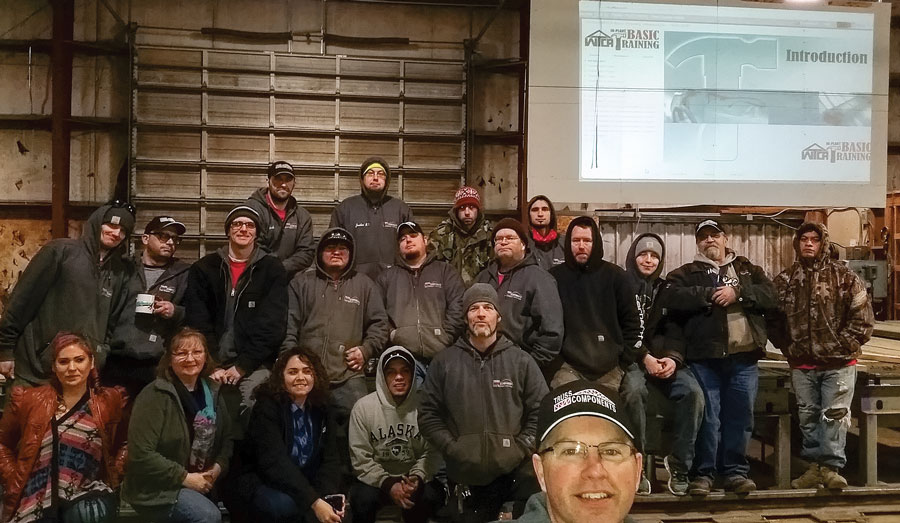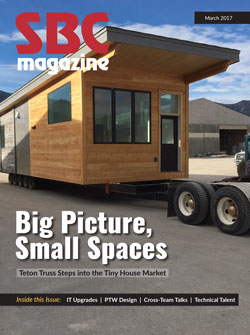Building Buy-in
Building Buy-in

Q: Talk me through the logistics—how do these meetings work?
Chad: Actually, we have them daily, and we have them with each shift. We hold them at a time when all of the office staff and production staff are available at the same time. Once a month we also involve the day and swing shift, so the production staff, the office staff, and both shifts all get to spend some time together. Usually the meetings are about 15 minutes, although we’ve had a few that last as long as 45 minutes. Occasionally, they only last five. Generally, I start each meeting and I share production statistics from the day before and then William, our production manager, handles the rest.
William: As Chad said, we start each meeting off with production numbers. Then we talk about what jobs we’re working on for that day and make time for any concerns people have or special projects we need to tackle. I also usually have a quote for the day and a brief activity. When we first started, those activities might have been something like “tell us your favorite kind of music” so that the group could get to know each other a little better. Then, they morphed into more serious personal discussions with questions like, “what’s one thing you’d like to change about yourself?” The meetings keep evolving. Now, each day of the week has a theme and we’re getting more employees involved in coming up with topics and leading the meetings.
Q: What made you decide to do this?
Chad: I was introduced to a book called 2 Second Lean by Paul Akers. He has a company that makes hardware for cabinetmakers. He’s been doing morning meetings for a few years, which is where I got the idea. One of the things that his book talks about is what he calls “eight areas of waste.” The eighth area, which is the most important one, is employee intellect. It’s an area of waste that, I know as a company, we had been wasting for years. We’ve been guilty of allowing our management to make decisions without involving the employees to any real extent. But they are the ones in the middle of the work, so they see the problems and solutions. As it turns out, our teams have lots of great ideas for improving the workplace.
Q: What were you hoping to accomplish with a joint meeting between the production and design departments?
Chad: Unfortunately, there was a feeling of division between the office staff and the production staff. To be honest, I don’t think that’s uncommon in our industry. A lot of times, the production staff were feeling like they have demands being laid on top of them, but that their voices don’t matter. Our meetings give them the opportunity to share their thoughts. So, to bring all of the employees together and have them interact with one another and have them learn that we all have a common goal has been really good for unity. Everyone has learned a lot after hearing the perspectives of others they don’t regularly work with.
William: You know, I was just hopeful that everyone would get more involved. I have a few individuals that are more reserved and tend to keep to themselves. After we started meeting, they ended up being the individuals that came to the forefront and opened up. Employees didn’t always want to open up, but since we started this process, many have expressed to me that they really enjoy the meetings and the opportunity to share what they are thinking. Plus, there’s just more overall excitement from everyone when they come to work each day.
Q: Can you share any examples of problems you were able to solve with these meetings?
Chad: Sure. We had a situation where our sawyers were having trouble with the information being batched out. Then, at our meeting, they got together with the design team, who explained why they were doing it the way they were, and the teams came together with a compromise and a solution. As another example, we had an issue with an employee who tended to be a little short fused. He’s a really hard worker, he just tended to be a little too easily set off. About three weeks into having the meetings, he spoke up and said, “I really like having these meetings. It really makes me feel like I’m important to the company.” After that, things have continued to improve.
Q: A lot of folks might say this is a great idea, but there’s no way they could afford to have all of their staff in a meeting for fifteen or more minutes every day. What’s your response?
William: Before we started having these meetings, our production was mediocre, but since we started having them, the efficiency of our production has increased dramatically. I don’t think we could afford to not have our meeting now. Plus, it’s more than just a meeting, this is employee investment. It’s not only about work; we want them to gain things they can take away to their personal lives. And, of course, we’re seeing benefits, too. For starters, we get more buy-in because people feel more like they are part of the team. They are invested in the company and they will stay with us longer.
Chad: The biggest surprise for me is that I was guilty of discounting how creative the employees could be with solutions and how deeply they cared about the company and their coworkers. It really opened my eyes. There is a lot of camaraderie that has come out of it. It’s made our company a better place to work and I don’t believe it would have happened without these meetings.

